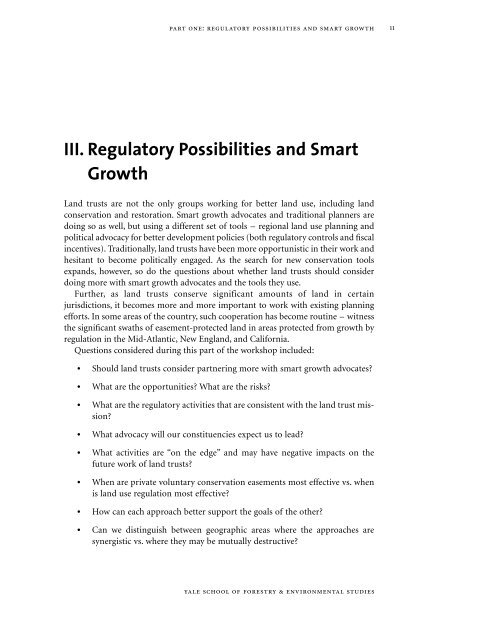Strategies for the Future of Conservation - Yale University
Strategies for the Future of Conservation - Yale University
Strategies for the Future of Conservation - Yale University
You also want an ePaper? Increase the reach of your titles
YUMPU automatically turns print PDFs into web optimized ePapers that Google loves.
part one: regulatory possibilities and smart growth11III. Regulatory Possibilities and SmartGrowthLand trusts are not <strong>the</strong> only groups working <strong>for</strong> better land use, including landconservation and restoration. Smart growth advocates and traditional planners aredoing so as well, but using a different set <strong>of</strong> tools – regional land use planning andpolitical advocacy <strong>for</strong> better development policies (both regulatory controls and fiscalincentives). Traditionally, land trusts have been more opportunistic in <strong>the</strong>ir work andhesitant to become politically engaged. As <strong>the</strong> search <strong>for</strong> new conservation toolsexpands, however, so do <strong>the</strong> questions about whe<strong>the</strong>r land trusts should considerdoing more with smart growth advocates and <strong>the</strong> tools <strong>the</strong>y use.Fur<strong>the</strong>r, as land trusts conserve significant amounts <strong>of</strong> land in certainjurisdictions, it becomes more and more important to work with existing planningef<strong>for</strong>ts. In some areas <strong>of</strong> <strong>the</strong> country, such cooperation has become routine – witness<strong>the</strong> significant swaths <strong>of</strong> easement-protected land in areas protected from growth byregulation in <strong>the</strong> Mid-Atlantic, New England, and Cali<strong>for</strong>nia.Questions considered during this part <strong>of</strong> <strong>the</strong> workshop included:●●●●●●●●Should land trusts consider partnering more with smart growth advocates?What are <strong>the</strong> opportunities? What are <strong>the</strong> risks?What are <strong>the</strong> regulatory activities that are consistent with <strong>the</strong> land trust mission?What advocacy will our constituencies expect us to lead?What activities are “on <strong>the</strong> edge” and may have negative impacts on <strong>the</strong>future work <strong>of</strong> land trusts?When are private voluntary conservation easements most effective vs. whenis land use regulation most effective?How can each approach better support <strong>the</strong> goals <strong>of</strong> <strong>the</strong> o<strong>the</strong>r?Can we distinguish between geographic areas where <strong>the</strong> approaches aresynergistic vs. where <strong>the</strong>y may be mutually destructive?yale school <strong>of</strong> <strong>for</strong>estry & environmental studies
















